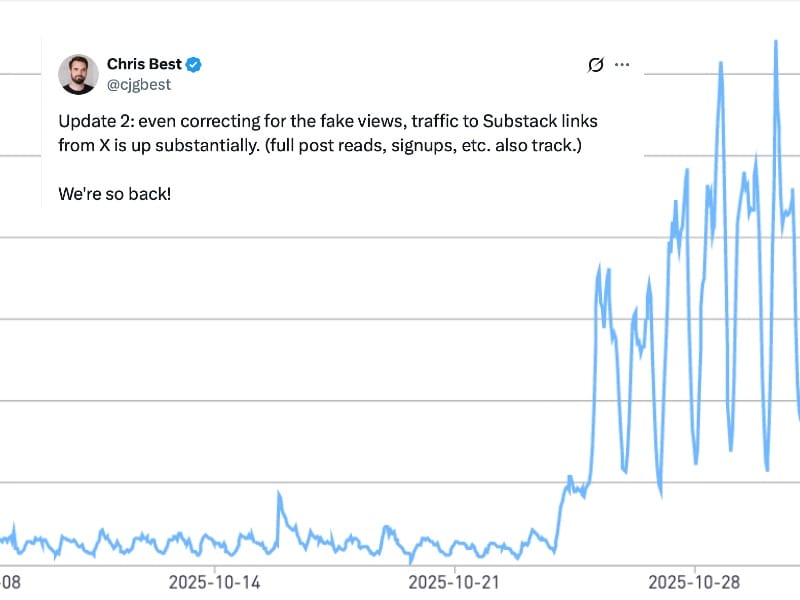X iOS update disables JavaScript during link prefetch, generating artificial traffic
X's November 5 iOS update automatically loads links before users click, creating invalid traffic that inflates publisher metrics and undermines advertising measurement standards.

X implemented link prefetching on iOS November 5, 2025, creating measurement challenges as automated content loading inflates metrics before users click. Platforms report substantial traffic increases comprised largely of non-human activity that violates industry standards for valid impressions.
X deployed a technical change to its iOS application on November 5, 2025, that fundamentally altered how the platform handles external links. According to Aaron, an analyst for MacRumors who examined the application code, the platform disabled JavaScript execution during the link prefetch phase while implementing automatic content loading before users actually click on shared URLs.
The implementation occurred at 4:33 PM on November 5, according to posts documenting the code changes. The modification set a configuration parameter labeled "ios_in_app_article_webview_disable_javascript_during_prefetch" to "true" within the application's technical infrastructure. JavaScript loads only after users actually click a link, separating the prefetch phase from genuine user interaction.
Platform product head Nikita Bier addressed the deployment timeline when another observer noted the change had only been active for three minutes before detection. The technical modification represented what X positioned as an improvement to the user experience, creating a new in-app browser that collapses posts when users click links while allowing continued interaction with like, repost, reply, and bookmark buttons.
Measurement distortion across multiple platforms
Substack CEO Chris Best initially reported a dramatic traffic increase from X on November 3, 2025, sharing analytics charts that appeared to show substantially higher referral volumes. The charts displayed sharp upward trajectories beginning around that date. Best stated he thought the changes were working, tagging Bier in his initial assessment of the traffic patterns.
The situation deteriorated rapidly. Best issued an update on November 4 at 5:20 PM stating that "most of the apparent lift is fake, unfortunately." He explained that X's new browser was pre-loading links before users actually viewed them, creating measurement artifacts that resembled genuine traffic. The prefetch behavior triggered analytics systems to record visits that never involved actual human engagement with the content.
By November 5 at 12:31 AM, Best provided a third update clarifying that even after correcting for fake views, "traffic to Substack links from X is up substantially." He noted that full post reads, signups, and other conversion metrics also tracked higher, suggesting some genuine traffic increases occurred alongside the measurement distortion. Best estimated a roughly 4x traffic jump from a previously low baseline, acknowledging that links were "really not working before" the changes.
Paul Frazee, a product manager at Bluesky, reported that X's prefetching system "ruined" the platform's metrics for measuring logged-out daily active users. Frazee explained that X started opening links in the background to accelerate loading times, generating extra traffic to numerous sites that appeared authentic in analytics systems.
Industry standards for invalid traffic detection
Nick Eubanks, VP of owned media at digital marketing platform Semrush, characterized the situation as "a classic case of metrics distortion caused by product experimentation at the platform layer," according to coverage in The Verge published November 7, 2025. Eubanks explained that X's browser pre-loads link content in the background, meaning the system fetches destination pages before any human actually taps or views them.
This implementation creates what Eubanks described as analytics inflation through multiple mechanisms. Click rates appear artificially elevated. Publishers, advertisers, and creators see traffic that might not correlate to actual human visits. The prefetch activity generates what industry measurement standards classify as General Invalid Traffic.
Invalid traffic comprises web activity that fails to meet quality or completeness criteria, according to Media Rating Council standards. The MRC defines invalid traffic as "traffic or associated media activity that does not meet certain quality or completeness criteria, or otherwise does not represent legitimate traffic that should be included in measurement counts."
Google's Active View methodology documentation specifically identifies prefetch traffic as General Invalid Traffic requiring routine filtration. GIVT identification focuses on "routine and list based means that flag: bots, spiders & crawlers, non-browser user agent headers, and prefetch traffic." The distinction between prefetch activity and genuine user engagement represents a fundamental principle in digital advertising measurement, separating machine-initiated requests from human-driven interactions.
Social media platforms have faced increasing scrutiny regarding invalid traffic rates. Pixalate's May 2024 Global Social Media Invalid Traffic Benchmarks Report analyzed 1.4 billion open programmatic ad transactions, revealing that TikTok exhibited an 18% estimated IVT rate among mobile app traffic, representing the highest rate and most significant month-over-month increase from 13% in April 2024.
Buy ads on PPC Land. PPC Land has standard and native ad formats via major DSPs and ad platforms like Google Ads. Via an auction CPM, you can reach industry professionals.
Technical implementation and excluded domains
X implemented the prefetch system with specific domain exclusions. Code screenshots shared by International Cyber Digest on November 6 at 1:08 PM revealed a configuration array containing multiple excluded domains. The list included "apple.com," "wayfair.com," "grok.com" (listed twice with one in a different color coding), "applink.instagram.com," "fb.me," "app-va.tiktokv.com," and "open.substack.com."
These exclusions indicate that certain platforms negotiated or received exemptions from the automatic prefetching behavior, potentially to avoid the measurement distortion affecting other destinations. The technical documentation showed these domains within a "value" array, suggesting a whitelist approach where specified destinations bypass the standard prefetch mechanism.
The exclusion list raises questions about competitive dynamics and platform relationships. Major social media competitors appear in the exclusion list, as do commerce platforms and X's own AI product Grok. The selective implementation creates asymmetric measurement impacts across the web, with excluded domains avoiding the invalid traffic generation while other destinations experience inflated metrics.

Implications for advertising viewability and attribution
The prefetch implementation fundamentally undermines advertising viewability standards that require actual human exposure to ad impressions. When X's application fetches webpage content automatically in the background, any advertisements present on those pages load without user intention to view the content or awareness that the page loaded at all.
This activity generates what appears to be ad impressions in publisher systems, but these impressions never had opportunity to be seen by actual users. Viewability measurement typically requires at least 50% of an ad's pixels to be visible on screen for a minimum duration. Prefetched content loaded entirely in the background fails this fundamental criterion, yet analytics systems may record these as delivered impressions.
The situation creates trust erosion between platforms, publishers, and advertisers. Publishers cannot reliably distinguish between genuine traffic from X and prefetch-generated invalid traffic without implementing sophisticated detection mechanisms. Advertisers paying for impressions or engagement on publisher sites receive inflated metrics that misrepresent actual campaign performance.
Attribution modeling becomes compromised when platforms inject artificial traffic into the marketing funnel. Multi-touch attribution systems that assign credit to touchpoints along the customer journey incorporate these invalid interactions, potentially over-crediting X as a traffic source while undervaluing channels that drive genuine engagement. Marketing teams making budget allocation decisions based on compromised attribution data may systematically misallocate resources.
Broader context of platform traffic manipulation
X's prefetch implementation follows patterns of platform behavior that prioritizes internal metrics over ecosystem health. Bier stated the new link setup addresses creator complaints about posts with links receiving lower reach. "This is because the web browser covers the post and people forget to Like or Reply," Bier wrote. "So X doesn't get a clear signal whether the content is any good."
The platform's solution optimizes for engagement metrics visible within X while externalizing costs to publishers and advertisers who receive degraded measurement quality. This represents a familiar pattern where large platforms pursue internal optimization goals that create negative externalities for smaller ecosystem participants.
Eubanks warned that the industry is "entering an era where metrics inflation through interface tricks, preloading, autoplay, and AI summarization will blur the line between user engagement and machine behavior." He stated that platforms wanting credibility with creators and advertisers will need transparency about how engagement is counted, separating previews from actual people.
The mechanism could constitute a form of automated traffic generation that some might characterize as spam-like behavior. The platform sends HTTP requests to external servers without user intention or awareness, consuming bandwidth and server resources while generating misleading analytics. Traditional definitions of web spam include automated systems that artificially inflate metrics, though X's implementation occurs through a mobile application rather than traditional web crawling.
Best acknowledged on November 5 that Substack estimated real views by examining proportions of other metrics that weren't occurring in the fake cases. He noted that X appears to be addressing the measurement issue, suggesting "this was just a bug that got introduced because they were trying to make it fast." Jonah Katz confirmed on November 5 that "Fix for false impressions going out in the next build."
Subscribe PPC Land newsletter ✉️ for similar stories like this one
Timeline
- November 5, 2025, 4:33 PM: X deploys iOS update disabling JavaScript during link prefetch phase
- November 3, 2025: Substack CEO reports apparent traffic increase from X platform
- November 4, 2025, 5:20 PM: Substack identifies most traffic increase as artificial from prefetching
- November 5, 2025, 12:31 AM: Substack confirms genuine traffic increase exists alongside invalid traffic
- November 6, 2025, 1:08 PM: Technical documentation reveals excluded domain list
- November 7, 2025: The Verge publishes analysis characterizing prefetch as metrics distortion
- July 2024: Pixalate report documents rising invalid traffic rates across social platforms
- April 2022: Media Rating Council updates invalid traffic detection standards
- June 2025: Google announces changes to MRC accredited metrics affecting invalid impression counting
Subscribe PPC Land newsletter ✉️ for similar stories like this one
Summary
Who: X implemented the technical change affecting iOS application users, with measurement impacts documented by Substack CEO Chris Best, Bluesky product manager Paul Frazee, and digital marketing analyst Nick Eubanks. Platform product head Nikita Bier acknowledged the deployment.
What: X deployed automatic link prefetching in its iOS application that loads webpage content in the background before users click, disabling JavaScript during the prefetch phase. The implementation generated artificial traffic that measurement systems recorded as genuine visits, creating what industry standards classify as General Invalid Traffic that violates Media Rating Council guidelines for valid impression counting.
When: The technical change deployed on November 5, 2025, at 4:33 PM, with measurement distortion identified by publishers on November 3-4, 2025. X indicated a fix for false impressions would appear in a subsequent build.
Where: The implementation affected X's iOS mobile application globally, with measurement impacts observed across external websites receiving traffic from X, including Substack and Bluesky. Certain domains including major social platforms and commerce sites received exclusions from the prefetch behavior.
Why: X stated the change aimed to improve user experience by allowing continued interaction with posts while viewing external links, addressing creator complaints that posts with links received lower reach because users forgot to engage after clicking. The implementation prioritized platform engagement metrics while creating measurement distortion for external publishers and advertisers who rely on accurate traffic attribution for business decisions.

